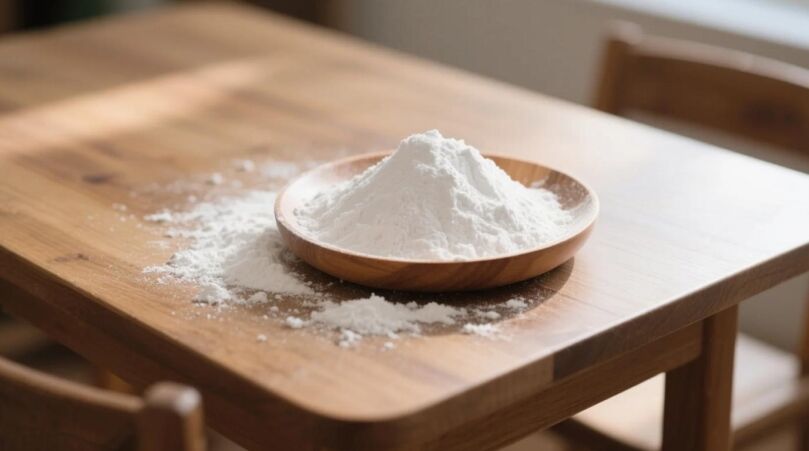What Is Konjac Flour?
Derived from the root of the Amorphophallus konjac plant, organic konjac flour is a soluble fiber powerhouse. Its active ingredient, glucomannan, absorbs 50x its weight in water, forming a gel-like substance. Used for centuries in Asian cuisine (think shirataki noodles), it’s now a keto and weight-loss darling. But does “organic” make it healthier? Let’s dissect the science.

Health Benefits: Why Konjac Flour Shines
1. Weight Management Warrior
- Zero Calories, Maximum Fullness: Glucomannan expands in the stomach, curbing hunger hormones like ghrelin.
- FDA-Approved Claim: “May reduce weight when combined with diet and exercise” (requires 3g/day).
2. Blood Sugar Stabilizer
- Slows Glucose Absorption: Lowers post-meal spikes (study: 21% drop in diabetics).
- GI = 0: No impact on insulin.
3. Cholesterol Crusher
- Binds to Bile Acids: Reduces LDL (“bad” cholesterol) by 10% in trials.
4. Prebiotic Power
Feeds Bifidobacteria and Lactobacillus, boosting gut diversity.
The Organic Advantage: Why Sourcing Matters
Conventional konjac often comes with hidden risks:
- Pesticide Residues: Non-organic farms use chlorpyrifos (neurotoxic insecticide).
- Bleaching Agents: Sulfur dioxide to whiten flour, triggering asthma in sensitive individuals.
Organic Konjac Flour Guarantees: ✅ No Synthetic Chemicals: USDA Organic certifies pesticide-free farming.
✅ Non-GMO: Wild-harvested or traditionally cultivated konjac.
✅ Clean Processing: Air-dried instead of chemically dehydrated.
The Dark Side: Konjac’s Risks and Side Effects
1. Digestive Disaster Zone
- Choking Hazard: Dry konjac expands in the throat—always presoak!
- Blockages: Overconsumption (>5g/day) without water can cause intestinal obstructions.
- Gas and Bloating: Rapid fermentation feeds gas-producing bacteria.
2. Nutrient Absorption Issues
- Mineral Binding: Glucomannan may reduce iron, zinc, and calcium uptake by 15%.
3. Medication Interference
- Reduced Drug Efficacy: Delays absorption of oral meds (take 2 hours apart).
4. Allergic Reactions
Rare but severe anaphylaxis cases linked to konjac protein sensitivity.
Organic Konjac vs. Alternatives
| Fiber Source | Calories | Soluble Fiber | Gut Impact | Organic Option |
|---|---|---|---|---|
| Konjac Flour | 0 | 90% | High fermentation | ✅ |
| Psyllium Husk | 20 kcal/tbsp | 70% | Gentle bulk-forming | ✅ |
| Oat Beta-Glucan | 30 kcal/tbsp | 50% | Mild prebiotic | ✅ |
| Inulin | 1.5 kcal/g | 100% | High-FODMAP risk | ✅ |
Winner for Satiety: Konjac. Winner for Safety: Psyllium.
Who Should Avoid Konjac Flour?
- Dysphagia Patients: Swallowing difficulties increase choking risk.
- IBS Sufferers: Fermentation worsens bloating and cramps.
- Pregnant Women: Limited safety data; mineral loss is a concern.
How to Use Organic Konjac Safely
- Hydrate Thoroughly: Soak 1 tsp in 1 cup water for 10 mins before adding to recipes.
- Start Low: 1g/day, gradually increasing to 3–4g.
- Pair with Nutrients: Take with vitamin C to offset mineral binding.
- Choose Certified Brands: Look for NuPasta or Slendier for organic, additive-free options.
The Verdict: Healthy with Heavy Caveats
Organic konjac flour is a potent tool for weight loss, blood sugar control, and gut health—if used correctly. Its risks (choking, bloating, nutrient theft) demand respect, not reckless use. For disciplined users prioritizing organic purity, it’s a fiber upgrade. For others, psyllium or oat fiber may be safer bets.
Gel smart. Don’t let fiber backfire.
Recommended Product
Organic Konjac Flour
Multi-Functional Ingredients for Gut Health, Weight Management & Clean-Label Innovation